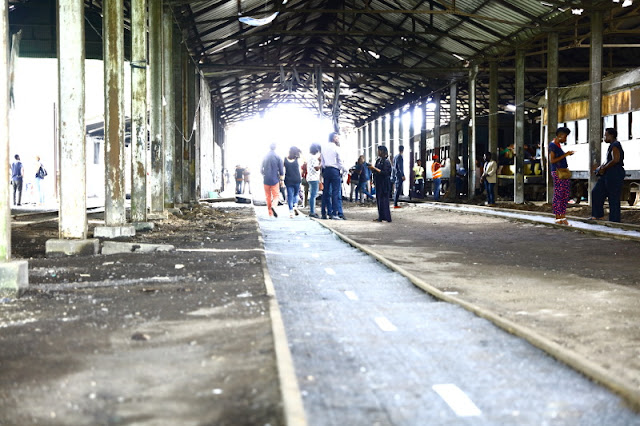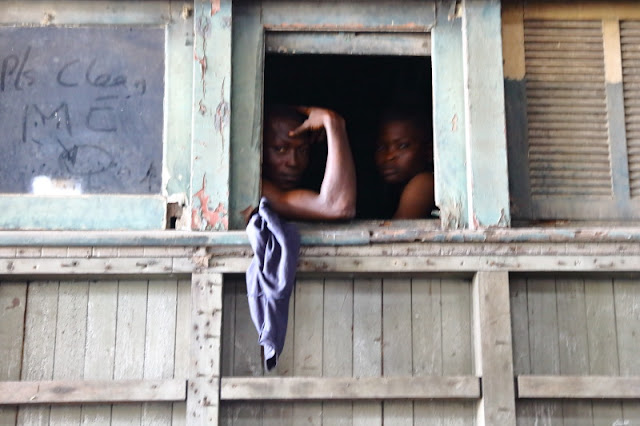 |
| Lagos Biennale, this way please |
The railway compound is a residential area abundantly provided with buildings that used to serve the railway industry back in the days. A firemen place, the headquarters of the railway company, warehouses, a shed to shelter and repair train coaches and a lot of housing for railway staff families. The compound is a large expanse, fairly green. There is an atmosphere of countryside where time would have stopped fifty years ago. Although it is next to Apapa road and the congested market of Ebute-Metta, the compound does not have any of the bustle that surrounds it.
A few wooden colonial houses still stand and one of them, called Jaekel house, is the headquarters of the Legacy association which focuses on preserving the legacy of the past centuries but also promoting tourism in Nigeria. They offer train rides once or twice a year from Lagos to Abeokuta.
Today is the day of the opening of the first Lagos Biennial of contemporary art and it is spread in several buildings of the compound. The clock is ticking. Well it is ticking for the artists and the organisers, few of which are putting the last touch to their art installations. So the biennial is not yet officially opened and visitors are kindly asked to wait for the official opening tour which should happen around 3PM, Nigeria time. The ground floor of Jaekel house is occupied by a large table at which sit the staff of the Biennial studiously busy creating labels for the exhibition and getting ready for the opening. The theme of the Biennial is "living on the edge".
 |
| the shed, main exhibition hall |
Another room has a tryptic video about African traders in China in the city of Guangzhou done by a Kenyan artist. About half a million Africans live in an area called Chocolate City. Nigerians, mostly Igbos, dominate the African presence and some of them have now families. The author was telling that there were 10 different Nigerian football teams and only one East-African team to give an order of magnitude of the Nigerian presence.
Upstairs the bathroom area has been re-tiled with white sheets of paper decorated with black drawings from an Angolan artist who presented a video on a ritual around the making of guarri out of cassava plants. He said his grand-mother used to do it and it had a particular meaning which he is yet to understand fully. He intends therefore to travel to Brazil to find traces of it if possible. He argued that cassava had been brought into Africa from the Americas which surprised some of the Nigerian visitors who shook their head in disbelief. Ah! It can't be possible!
On the theme "living on the edge", an Asian lady living in Lagos met several Lagosians in various areas of the city to ask them what the theme could mean for them. She presented there interview next to a picture of her with them if they accepted to be photographed.
 |
| the fight against corruption |
A few meters away stood the shed where more artworks were presented along train carriages. Despite the presence of a generator, power was not yet on, which handicapped some of the works like a plant loaded with sensors to pilot the movement of its branches based on certain inputs.
It was somewhat difficult to understand all the works as none of them had yet been labelled but some where explained by the artists who stood next to them to gather feedback.
Dunja Herzog presented a selection of mirror based furniture together with a few vintage objects from the UTC, a food company, that she found in an open-air market in Ikeja.
A series of photographs from the early building of Eko Atlantic, was questioning the creation of this new city on reclaimed land which was meant to protect the coast of Bar Beach from erosion and has displaced a number of poor people who used to live there. Cities expand onto new pieces of land which become rich at the expense of those who are being asked to vacate the place.
I enjoyed the representation of anti-corruption enforcement by EFCC as a boxing ring with EFCC staff as arbiters and around which onlookers with travel bags full of cash were witnessing the fight going on. Ayo Akinwande, the artist, was commenting that most people passively look at the corruption taking place, few people would actually expose themselves and fight it.
 |
| sweet talk in a carriage: an impromptu performance by local residents |
In the middle of the exhibition hall, cozily seated by the only window of a wooden carriage, two local residents, a man and a women, were engaged in a sweet chat session which looked like an spontaneous performance in itself.
The description of the art gallery in an old railway station was wonderful. and I understand how artworks dealt with such thorny topics as African migration to the north.
ReplyDeleteTaher
Spelling errors: its called Jaekel house not Jaeckel house and Ilukwe house not Ikugwe
ReplyDelete